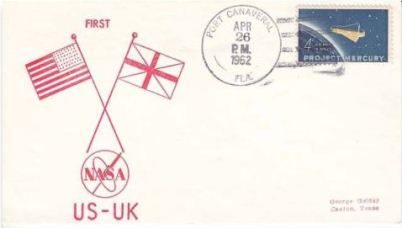Space Cover 292: Ariel 1Ariel 1 (also known as UK-1 and S-55), was the first British satellite, and the first satellite in the Ariel program was launched on April 26, 1962 from Cape Canaveral. Its launch made the United Kingdom the third country to operate a satellite, after the Soviet Union and the USA.
Ariel 1 was designed to contribute to the current knowledge of the ionosphere and of sun-ionosphere relationships. The satellite was a 137 pound cylinder with a 23 inch diameter and a height of 9 inches. A tape recorder and instrumentation for one cosmic-ray, two solar emissions, and three ionospheric experiments were on board the satellite. Except for failure at launch of the solar Lyman-alpha experiment, the spacecraft operated nominally until July 9, 1962. Between that date and September 8, 1962, spacecraft operation was limited. The spacecraft was operated again from August 25, 1964, to November 9, 1964, to obtain data concurrent in time with Explorer 20.
Ariel was a British satellite research program conducted between the early 1960s and late 1970s. Six satellites were launched as part of the program, starting with the first British satellite, Ariel 1, which was launched on 26 April 1962, and concluding with the launch of Ariel 6 on 2 June 1979. The first four were devoted to studying the ionosphere, the remaining two to X-ray astronomy and cosmic-ray studies.
The program was conducted by the Science Research Council. The first two spacecraft were constructed by the United States National Aeronautics and Space Administration,[1] with subsequent spacecraft being produced in Britain. All launches were conducted using American rockets; Ariel 1 on a Thor-Delta, and the remainder on Scouts.
Pictured is a Goldcraft cover for the launch of Ariel 1.












